Scandals, Myths, and Advertising Stats at WSOP Main Event
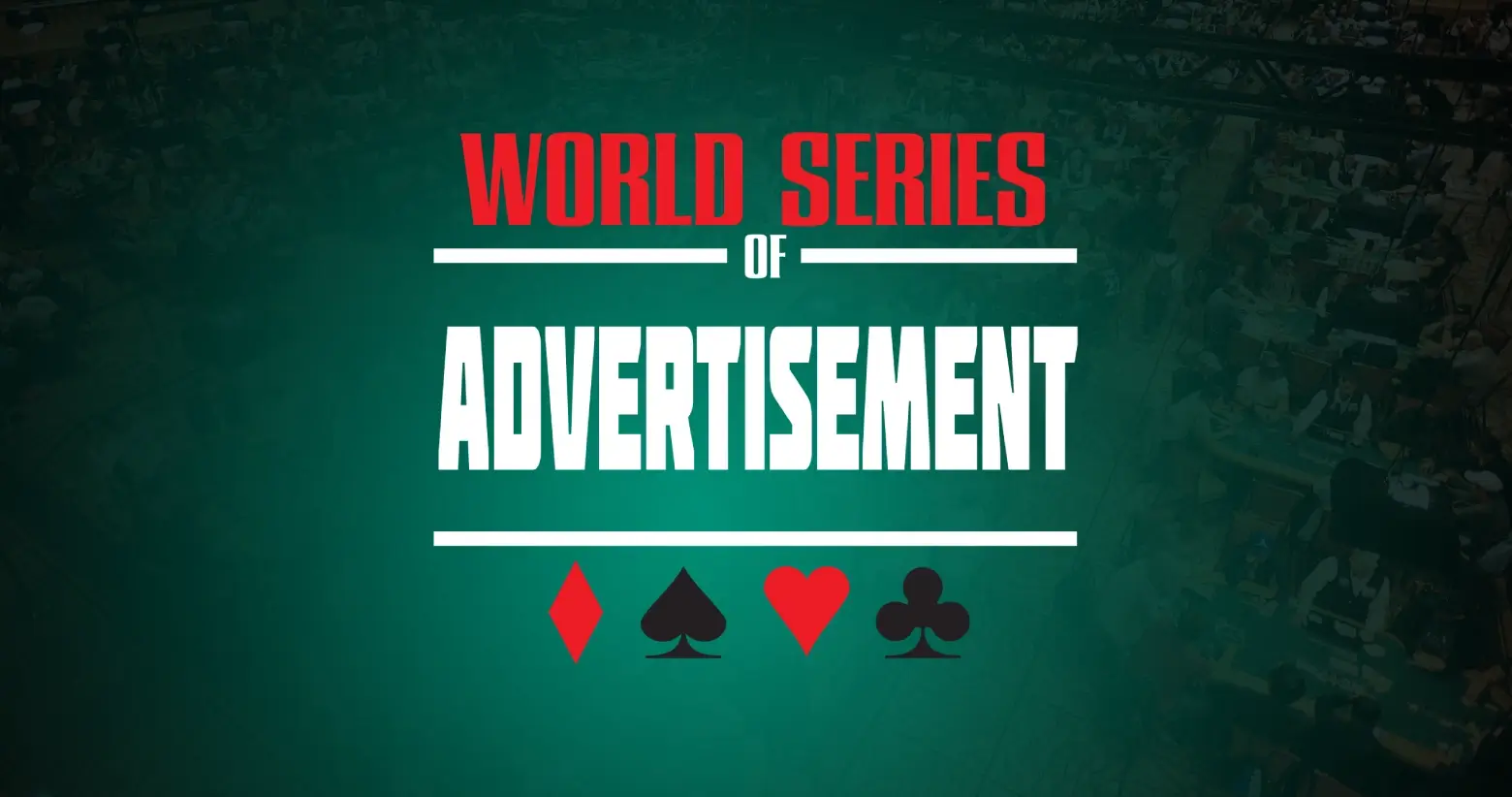

- Fact Checked by: PokerListings
- Last updated on: July 25, 2025 · 7 minutes to read
You’re likely accustomed to the commercial prominence of poker, where professionals often represent poker rooms, series have title sponsors, and WSOP finalists wear branded attire reminiscent of Formula 1 cars.
But it wasn’t always this way.
If we look at early WSOP photos, predictably, there’s no advertising on the players. Back then, Johnny Moss couldn’t even imagine his expensive shirt carrying a patch promoting any brand.
So, when did this change?
To avoid recounting the entire 50-year WSOP history, let’s jump directly to the pivotal moment—2003, when Chris Moneymaker won the WSOP, initiating the “Moneymaker Effect.”
By this time, brands like PokerStars and partypoker were already present. ParadisePoker, the previous industry leader, had already fallen behind but would make another attempt to regain market share.
Let’s look at the 2003 WSOP Main Event final table:
Only two out of nine players promoted brands. Chris Moneymaker wore a PokerStars cap and polo, while Dan Harrington sported an 888 cap. The other players, as well as the poker table itself, carried no advertising.
This marks our starting point.
The Beginning
We examined each WSOP Main Event final table from 2003 through 2025, documenting every sponsorship patch, hat, and table signage.
Observe the peak of the poker boom in 2010, just before Black Friday:

Note that in 2010, Michael Mizrachi made his debut at the WSOP Main Event final table but finished in fifth place. In 2025, he returned and became the champion.
But before diving into the analytics, let’s debunk a few myths.
Myths about WSOP Champions
Myth #1: Joe Hachem and Greg Raymer represented PokerStars
You can come across this myth both in posts and even from AI. This is a so-called Mandela Effect. Many people are convinced that Joe Hachem was yet another PokerStars representative who won the Main Event in 2005.
Here’s a photo of Joe Hachem during the game:
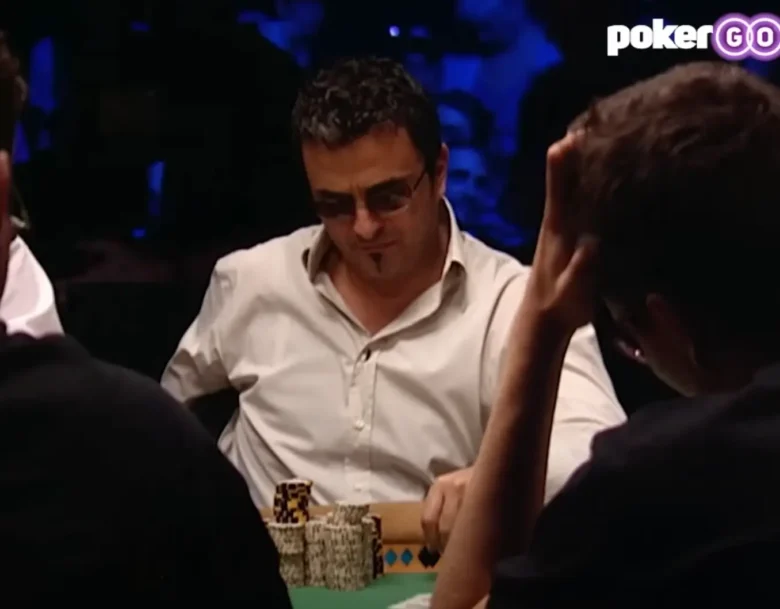
As you can see, he wore no advertisements. The tournament ended on July 15, 2005, but Joe signed with PokerStars on November 1, 2005.
Because Joe later became strongly associated with PokerStars through extensive advertising, people mistakenly recall him representing the brand from the beginning.
The situation with Greg Raymer was similar. He was not a brand ambassador before winning and signed only afterward. Although he qualified via a PokerStars satellite, unlike Chris Moneymaker, he didn’t wear branded attire.
Myth #2: Chris Moneymaker was a PokerStars ambassador
In fact, Moneymaker’s PokerStars contract came after his victory. Chris wore a PokerStars cap and polo because he qualified through their satellite, not because he was their ambassador. He became an official ambassador only after winning.
Myth #3: Players earn millions from advertising
During the poker boom, non-poker brand sponsorships (such as soda or clothing companies) typically cost about $10,000 per event. Adjusted for inflation over the subsequent 15 years, this equals roughly $16,000 in 2025. Sponsorship deals were negotiated directly with players, and tournament organizers could (and regularly did) prohibit certain advertisements.
Advertising Facts
- Sometimes sponsorship deals depend on players reaching certain tournament stages. For instance, in 2018, eventual champion John Cynn started the final table without branding but represented 888Poker during heads-up play.
- Beyond poker and casino brands, advertising frequently includes alcohol brands, e-cigarettes, dietary supplements, and energy drinks.
- Nonprofit organization advertisements regularly appear on finalists for free.
- Organizers sometimes prohibit specific advertisements at the last minute.
WSOP Brand Statistics
Over the analyzed period from 2003 to 2025, we identified a total of 74 unique brands appearing at WSOP Main Event final tables, covering player sponsorships and table/hall advertisements. On average, approximately 2 brands per year appeared on players, while table and hall ads averaged nearly 3 brands per year. The breakdown is: 15 poker rooms, 26 poker-related brands, 10 casino brands, and 23 non-poker brands.
We overlooked the clothing brand advertisements (Nike, BOSS, and others) that appeared on the players naturally, and we also failed to account for some non-poker-related advertising, such as yacht clubs and real estate agencies. This is due to the fact that it’s not always possible to identify the corresponding brand based on their logos.
Poker Brand Sponsorships on Players
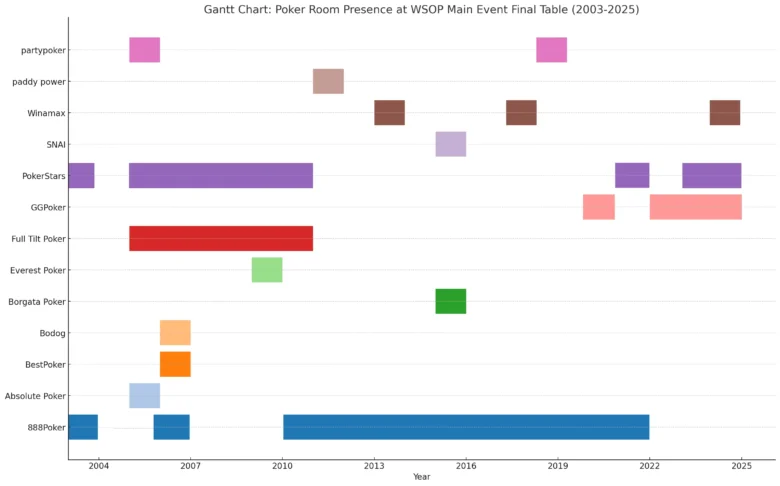
The first advertisement appeared on Chris Moneymaker’s polo in 2003—PokerStars. While Chris wasn’t yet an official ambassador, PokerStars’ marketing team strategically highlighted satellite-qualified players. Simultaneously, Dan Harrington promoted “888,” as the brand “888Poker” had not yet emerged.
Gradually, brand presence increased, leading to intense competition between PokerStars and Full Tilt Poker, halted abruptly by Black Friday.
Post-Black Friday, 888Poker dominated advertising until GGPoker emerged, eventually becoming the industry leader and acquiring WSOP branding rights.
Table and Hall Advertising
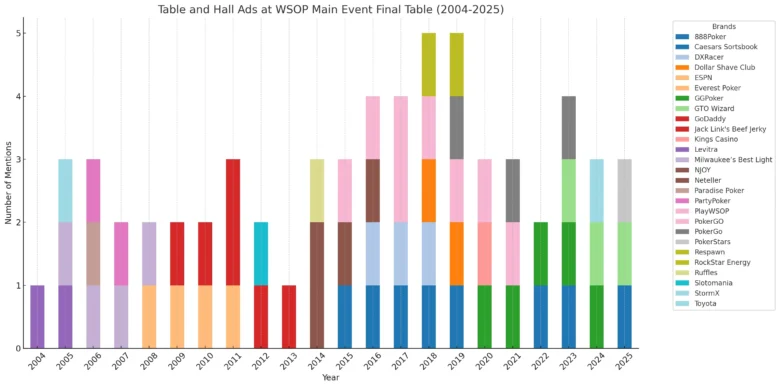
Initially, tables had no extra advertising aside from the host casino’s mention. The first additional ad appeared in 2004—a pharmaceutical product, Levitra, advertised for several years. Soon, Milwaukee’s Best Light beer and Jack Link’s Beef Jerky joined.
This suggests advertisers aimed relevant products toward male audiences before poker brands solidified their ecosystem.
Comparing subsequent years reveals significant differences in advertised product categories. Recently, poker software (GTO Wizard), social poker apps accessible to US players (PlayWSOP), and a single poker brand dominated.
Notably surprising was PokerStars advertising at the 2025 final table after WSOP rights had transferred to NSUS, GGPoker’s parent company.
Players with and without Advertisements
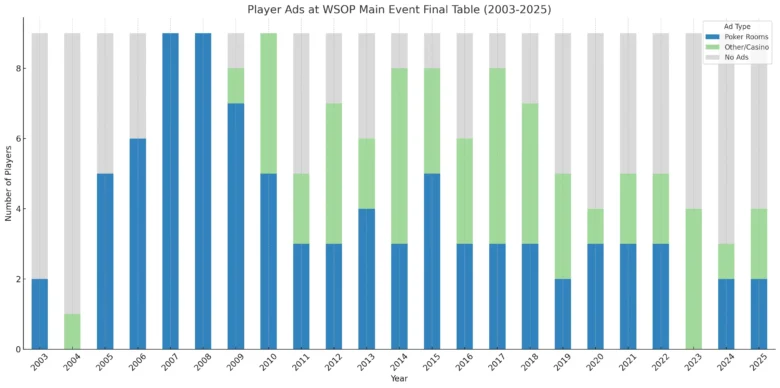
This graph categorizes player apparel advertisements into three groups: poker rooms, no advertising, and other categories (nonprofits, casinos, poker-related platforms, drinks, pharmaceuticals).
Initially, unsponsored players dominated tables. However, during the poker boom, every available spot featured poker brand advertisements due to intense competition between PokerStars and Full Tilt Poker.
After “Black Friday,” Full Tilt Poker disappeared, and PokerStars lost the US market. Non-poker brands appeared, and unsponsored players increased again.
Recently, possibly due to WSOP ownership changes, restrictions on specific brand advertisements arose, reducing poker-brand visibility on players.
PokerStars vs Full Tilt Poker
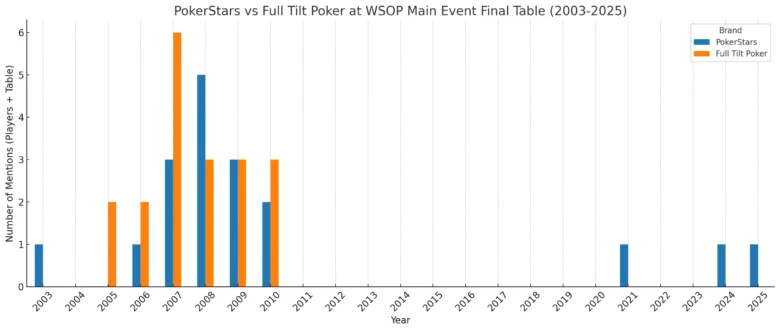
We studied PokerStars vs Full Tilt Poker rivalry at the poker boom’s peak. PokerStars initially invested heavily in final table advertising, but Full Tilt Poker aggressively took over after UIGEA. FTP notably targeted the US market through professional player sponsorships.
The absence of PokerStars branding in 2004 and 2005, when Greg Raymer and Joe Hachem won, is explained in the myths section. Reviewing these finals confirms neither player wore PokerStars apparel at the event; both signed afterward.
Post-Black Friday, Full Tilt Poker never recovered, disappearing from advertising entirely. PokerStars shifted its strategy to athletes and influencers, ceasing final-table player sponsorships. 888Poker filled this vacuum after Black Friday.
Advertising-Related Scandals
2025 WPT Advertising Ban
Yearly, WSOP Main Event final tables become subjects of scandals and debates. In 2025, the controversy arose when WPT advertising was restricted as a competing series. At least two players (Adam Hendrix and Braxton Dunaway) planned to represent WPT brands, including ClubWPT Gold, but received warnings from tournament director Jack Eiffel just before play began.
Jack came up to me as I entered and told me the patch has to come off because of the issues between wpt and wsop earlier. I told him this is completely different as there is no further money to win and he said it didn’t matter. I had to take it off or couldn’t play. Soft. https://t.co/rLBp5RUm0t
— Adam Hendrix (@AdamHendrix10) July 16, 2025
Also happened to Braxton Dunaway he wore a patch today quickly removed after me.
— Adam Hendrix (@AdamHendrix10) July 16, 2025
Even free advertisements from nonprofit organizations were banned:
I had a Foundation for Fallen Officers and the @TheGrinder44 was not allowed to wear my Fallen Heroes patch at the 2010 Main event FT after he wore it all year. Many did during the event, Kelly Kim, Chino Rheem, Mark Seif, Kristy Gates Very disappointing I wasnt giving them $$ to…
— Scott Diamond (@Deputysd) July 16, 2025
2015 DraftKings Advertising Ban
In 2015, WSOP organizers removed DraftKings branding during the final table broadcast following sharp US criticism. Notably, DraftKings itself requested the removal, distancing the brand from poker.
Adding intrigue, finalist Max Steinberg qualified via a $27 DraftKings satellite and was contractually obliged to wear the brand’s advertisement.
What We Learned
After reviewing 22 years of WSOP Main Event video footage, we observed how player and table advertising evolved. Here’s what we learned:
- Before placing an ad, make sure tournament organizers will allow it — or include a clause in the contract that ties payment to ad visibility.
- Sponsorships often change depending on the tournament stage. New sponsors may appear at 4-max or heads-up — and those spots usually come at a premium.
- Hats are by far the most visible branding during broadcasts — they’re constantly shown in close-ups.
- T-shirt logos are rarely readable on camera.
- Avoid complicated logos — make your website name clear and readable.
- Choose players who are expressive and active at the table. No one wants to watch a guy in sunglasses and a hoodie who doesn’t say a word all day.
- If you’re advertising a product — show the actual product. After years of Jack Link’s Beef Jerky sponsorships, we never saw a single player eat one on camera.
- Combine video exposure with online support: run a parallel social campaign during the WSOP — reactions, memes, behind-the-scenes stories from the player — it all adds synergy.
-
- 100% up to $2000
T&Cs Apply | Play Responsibly | GambleAware
18+ | Play Responsibly | T&C Apply
-
CoinPoker4.1
- 33% Weekly
- 150% up to 2000$
T&Cs Apply | Play Responsibly | GambleAware
+18 / T & C apply / Play responsible
-
Stake.US Poker4.3
- Rakeback 5%
- $55 Stake Cash + 260K Gold Coins
T&Cs Apply | Play Responsibly | GambleAware
18+ | Play Responsibly | T&C Apply
-
- 100% up to $1000
T&Cs Apply | Play Responsibly | GambleAware
T&Cs Apply | Play Responsibly | GambleAware
-
T&Cs Apply | Play Responsibly | GambleAware
18+ | T&Cs Apply | Play Responsibly | GambleAware


